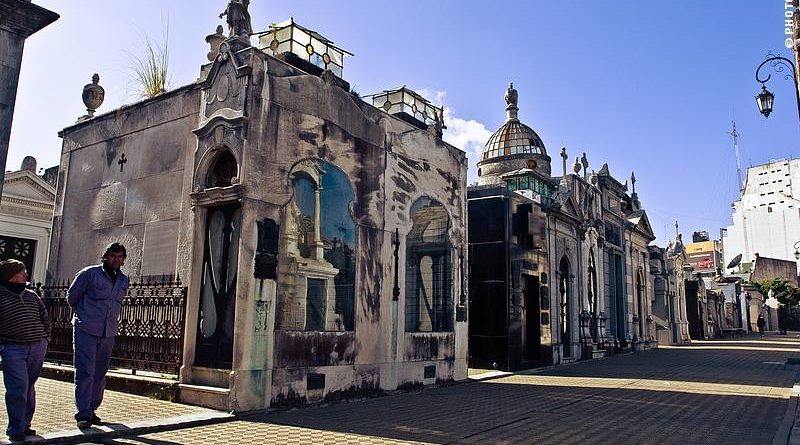The Cemeteries of Argentina
There are few countries on earth more loud, flamboyant and obvious than Argentina in their expression of religious zeal. For centuries a stark and orthodox form of Roman Catholicism has dominated the country’s religious makeup, manifesting itself in a number of festivals, processions and rituals throughout the year that are at once instantly recognisable as Argentinian through and through. It’s an aspect of the national character that simply can’t be ignored, and one that continues to inform and transform most all the aspects of daily life here.
For the architecture-hungry visitor, this deep piety is nothing but good news. From even the smallest town stead of the Argentinian Andes to the sprawling cityscapes of Buenos Aires and Córdoba, you can pretty much be sure that there will be at least some kind of religious monument to uncover, whether it be a small and homely wood-built church, or dominating cathedral complex with elaborate adornments to boot.

But with churches come graveyards, and with religious orthodoxy so often comes a veritable cult of the dead. Accordingly Argentina is home to some truly magnificent graveyards and cemetery sites that, while perhaps not immediately appealing to a tourist who’s come to sample the energetic life of this country, provide a unique glimpse of a nation that’s largely in the grip of a mystical obsession with the afterlife. Think grandiose family tombs and richly decorated headstones, towering mausoleums and endless seas of monumental graves; a genuine artistic product of Argentina’s religious devotion.
But of all the grave sites and cemeteries in Argentina there is one that stands out as the most prestigious and famous of them all. It’s sprawled over 14 acres of downtown Buenos Aires, and has been commended by some of the world’s most totemic travel guides and media outlets (think CNN and BBC) as one of the finest, most interesting and truly beautiful sepulchre sites in the world. Constructed at the same time as the Iglesia de Nuestra Señora del Pilar (Our Lady of Pilar Church) by the religious brotherhood, the Order of the Recoletos (from which the gravesite gets its name), the La Recoleta Cemetery is home to the biggest concentration of famous graves and mausoleums is all of Argentina.

Amongst the people buried here are Argentina’s much-loved former first lady, María Eva Duarte de Perón (most commonly referred to as simply Eva Peron or Evita), the famous Argentinian writer and winner of global literary prizes, Adolfo Bioy Casares, an array of well-known national film stars from the 20th century, a number of leading female academic writers and no fewer than 19 individual former presidents of Argentina. With such a line-up of big name graves, it’s perhaps easy to see why the La Recoleta Cemetery is no longer simply a place to mourn and remember the dead, but also a focal point of political, religious and cultural pilgrimage for locals and travellers alike.
In terms of architectural wealth, the La Recoleta Cemetery is without question the finest site of its kind in the country, and possibly all of South America. Nestled amidst the towering high rises of downtown Buenos Aires, it’s overshadowed by flats and business buildings that cast an ominous and surreal shadow over the patchwork of grandiose graves.
The overarching architectural theme is neo-classism, with many of the monuments adorned in grand style, like the formidable memorial to José Clemente Paz; an elaborate marble monolith of ascending angels and religious iconography.
However, while La Recoleta is far and away Argentina’s most visited grave site and also its most commented on in terms of tourism, the Chacarita Cemetery has to take the prize for its largest. Originally instituted as an out-of-town spot to dispose of the dead at the height of Buenos Aires’ destructive yellow fever epidemic of the early 1870s, it now dominates no less than 95 hectares of land near to the Federico Lacroze metro station.

For superstitious types and ghost hunters, the Chacarita Cemetery will prove to be particularly interesting. A stroll here will take you meandering around lichen-covered headstones and eerie monolithic protrusions adorned with angelic figurines, while there are a number of well-known myths and spooky stories that originate in the grounds.
The Chacarita Cemetery is home to a number of famous grave sites too, particularly those of national artists, poets and theatrical luminaries. Don’t miss the sepulchres of Carlos Gardel, Aníbal Troilo and Alfonsina Storni, three of Argentina’s artistic icons. For those looking for something of a more detailed introduction to Chacarita, regular tours of the grave sites are organised throughout the year, but visitors should check ahead for dates.
